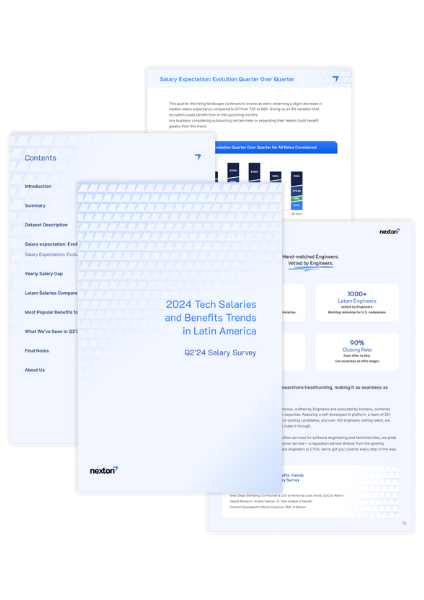Nearshore headhunting in Latin America done right, is the safest bet you can make to solve the increasing challenges in on-site hiring in the US.
Hiring in the United States is becoming more and more difficult with the variety of issues straining company resources and stunting growth. From the scarcity of qualified candidates, and high rates of turnover, to the rising costs of salaries and benefits, businesses face numerous hurdles in acquiring top talent.
Nearshore headhunting in Latin America provides access to skilled professionals at a lower cost and with better cultural and time zone alignment. This blog explores the major challenges of hiring in the US and demonstrates how nearshore recruitment can be a strategic advantage.
Challenges of Hiring in the US vs. Nearshore Headhunting
Talent Shortage vs.
The US job market is experiencing a significant talent shortage, especially in specialized fields such as data science, cybersecurity, and artificial intelligence. A report by HiBob highlights that the lack of qualified candidates is a top hiring challenge, with 40% of companies struggling to find the right fit for their roles.
Access to Skilled Talent
Nearshore recruitment in LATAM opens doors to a growing pool of highly skilled professionals in tech and other industries. Companies can tap into this talent pool and access experts with the same level of proficiency as those in the US, effectively alleviating the talent shortage. This access can lead to a productivity increase of up to 20%.
High Costs vs.
Hiring in the US comes with high financial burdens. According to the LaSalle Network, salaries for in-demand roles are driving up costs significantly. For example, professionals in data science and cybersecurity command premium salaries, making it expensive for companies to attract and retain top talent. Specifically, salaries for these roles can be up to 20% higher than average.
Cost Efficiency
Nearshore headhunting in LATAM offers a significant cost advantage. Salaries for skilled professionals in LATAM are considerably lower than those in the US, allowing companies to save up to 50% on salaries and benefits. This makes nearshore recruitment a cost-effective solution for meeting staffing needs without sacrificing quality.
Lengthy Hiring Processes vs.
The time-to-hire in the US has increased, with companies taking an average of 44 days to fill a position, up from 43 days the previous year. This delay not only impacts productivity but also increases the risk of losing candidates to competitors. Approximately 71% of talent acquisition leaders report that their time-to-hire has increased over the past year.
Scalability and Flexibility
Nearshore recruitment in LATAM allows companies to scale their teams quickly and efficiently, based on project demands. This flexibility eliminates the long hiring processes typical in the US, enabling businesses to respond rapidly to market changes. Companies can scale their teams up or down by 40% as needed, reducing the burden of extended hiring timelines.
In more specific cases, such as Nexton's, you can start interviewing hand-matched candidates, vetted by engineers as soon as in 3 days. Ensuring a perfect match for the position.
Employee Turnover vs.
High employee turnover rates add to the complexity and cost of hiring. The Society for Human Resource Management (SHRM) notes that turnover rates have remained high post-pandemic, further complicating talent acquisition efforts. Specifically, turnover rates have increased by approximately 10% since the pandemic.
Enhanced Retention Rates
Nearshore recruitment offers an opportunity to reduce turnover rates. In LATAM, competitive compensation and benefits packages, combined with opportunities for career growth, contribute to higher employee satisfaction and retention. Companies that invest in nearshore teams often experience lower turnover, stabilizing their workforce and reducing the recurring costs of rehiring.
Competition for Talent vs.
The competitive landscape in the US means companies are often outbid by rivals offering better compensation packages and benefits. This competition drives up costs and makes it challenging to secure top-tier talent. About 40% of professionals globally value higher salaries the most when considering new roles.
It's becoming more and more imminent the need to explore other options and nearshore headhunting is starting to shine its light onto the problem and offering a very compelling solution.
Cultural and Time Zone Alignment
While talent competition is fierce in the US, nearshore recruitment in LATAM provides companies with access to top-tier professionals without the same level of bidding wars. Additionally, nearshore teams in LATAM benefit from cultural compatibility and similar time zones, which enhance communication and collaboration. This alignment helps improve project timelines by up to 30%, creating a more seamless work environment that rivals the benefits of US talent.
Overcoming these challenges
The challenges of hiring in the US are significant, but nearshore headhunting in LATAM offers a compelling alternative. By reducing costs, accessing a skilled talent pool, and improving cultural and time zone alignment, companies can overcome many of the obstacles they face in the US job market. Investing in nearshore recruitment not only provides immediate benefits but also positions businesses for long-term success in an increasingly competitive global economy.


